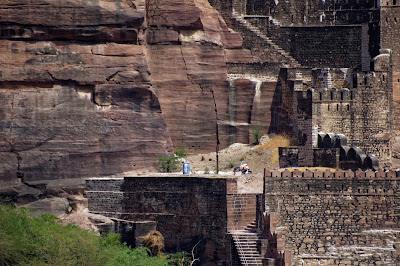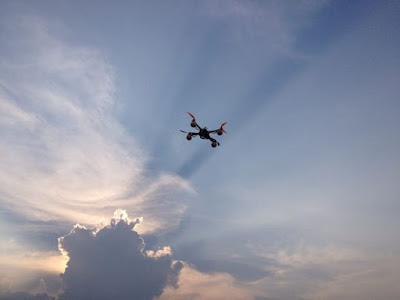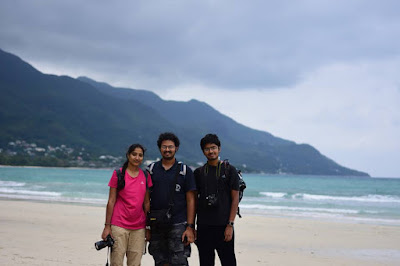 |
| The ramparts of Mehrangarh fort, Jodhpur. |
The motivation behind this trip was from two sources. Sandeep Saraswat's wedding in Haldwani and whitewater rafting in Rishikesh. So, we initially planned to visit Uttarakhand from 16th June till 19th June and then head back to Hyderabad by train from Delhi. I happened to change from BendFlex back to GwynnieBee in May and this plan changed. GwynnieBee has an office in Delhi and I thought of extending my trip by working there for a couple of days and then visiting another of my long dreamt-of destinations, Jodhpur. And this is what we did.
 |
| Muhammad Shah Sayyid's tomb. Lodhi Gardens, Delhi. |
 |
| Connaught Place, New Delhi. |
We started from Bangalore by an early morning SpiceJet flight to Delhi on 16 June. Reaching Delhi by 8:30AM, we set out by metro to visit Lodhi gardens and Safdarjung's tomb. The Lodhi gardens is home to the entire Lodhi dynasty's mausoleums (except Sikandar Lodhi) and a few other Delhi sultans' mausoleums. After walking around in the sweltering heat, we set off by walk to Khan market for lunch. We met up with Himanshu from GwynnieBee Delhi office there, who came to collect our laptops and offload at least 3 Kg from our backs. We had a nice meal in an upscale Euro-themed restaurant at Khan market and then took an Uber to Connaught Place. At CP, we walked around a bit, window shopping. We had a train out of Old Delhi station at 4PM. We took a metro from Rajiv Chowk to Chandni Chowk at 2:30, reaching Old Delhi by 3 PM. We then learnt that the train was an hour late and we loitered around in the station for two hours. I reached the verge of dehydration after spending the entire day in the hot sun, carrying around a huge rucksack. We finally got the train and were relieved to be in the AC chair car compartment. The train, the Uttarakhand Sampark Kranti express, chugged along slowly till Ramnagar. It arrived 2 hours late, at 10:30 PM. We walked up to Hotel Himalaya in Ramnagar. We were shocked to find that our RedBus reservation did not reach the hotelier and there were no beds left for us. This is in-spite of paying the money beforehand. The owner did not even acknowledge that he had any connection with RedBus. After some deliberation, he offered us a convertible bed in his office for the night on the condition that we pay him an extra Rs. 2000 the next morning. We had no option and so we took it.
 |
| Corbett National Park. |
 |
| Weaver birds. Corbett National Park. |
 |
| Green bee-eater. Corbett NP. |
We woke up at 5AM on 17th and set off to the Jhirna safari zone, Corbett National Park by 5:30AM. There were no big carnivores to be seen that morning but the landscapes were beautiful, thanks to the daily rains. There were birds such as the green bee-eater and the weaver. Spotted deer, langurs and peacocks all set the perfect image of the Indian bush. The safari ended by 9:30 AM and we reached the hotel. We rang up RedBus customer care and after some shouting around, they sent a confirmation to the hotel along with the money and we had to pay nothing extra. We walked up to the Ramnagar bus stand to catch anything that goes to Moradabad. We had a few rundown buses and some sharing taxis to choose from. We finally got into a sharing van that dropped us at Moradabad by around 2 PM. We checked into the Hotel Maharaja near the Moradabad railway station, which was by far the best hotel there was within walking distance. After resting the entire day, we caught the midnight train from Moradabad to Haridwar.
 |
| Ganga temple. Har Ki Pauri, Haridwar. |
 |
| Ganga Aarti. Har Ki Pauri, Haridwar. |
 |
| Lakshman Jhula. Rishikesh. |
 |
| Sunrise at Haridwar. |
 |
| An art shop in Rishikesh. |
The train dropped us at Haridwar at 3AM. We spent the next 19 hours on foot, carrying around our entire luggage. After sleeping on a bench at Haridwar railway station for an hour, we caught a cycle rickshaw to Har Ki Pauri ghat. This is the place where the Ganga Aarti happens everyday in the morning and evening. We were in time to witness the morning Aarti. We loitered around till 8AM, observing the myriad of people who visit the place to bathe in the Ganges for atonement. There are also the other kind of people who carry around a selfie stick to take selfies of themselves bathing. There are also a variety of holy men and pseudo-holy men. In all, one can spend countless hours in a place like this, just observing. We had booked a GoZoomo cab to drop us at Rishikesh and the driver arrived at 8AM. It was a huge Ertiga for just the two of us. It dropped us right at Lakshman Jhula in Rishikesh. We walked across the bridge and into Tapovan, to Govind Sharma's home, which was around a kilometre away. Govind, who was my classmate and hostelmate at IISc, hails from Rishikesh and his family owns a gem and handicraft business in Tapovan. We walked across winding alleys and climbed flights of stairs to reach their shop and home. We put our luggage at their place and immediately went for rafting. We chose to do the shorter 9Km route. It was definitely a lot more fun than what I remember from rafting in the Beas near Kullu. We recorded the whole thing on our new Decathlon GEye 500. We returned to Govind's house to take bath and had lunch with his family. After that, we set out with our entire baggage to roam the streets of Rishikesh. We walked approximately 3Km to Ram Jhula and Paramarth Niketan. After having a break in a South Indian coffee shop, we caught an auto rickshaw to the Rishikesh railway station road. Govind's uncle specifically asked us to attend the evening Ganga Aarti at Triveni Ghat, which is near the railway station. So, we got off at the main road and walked the 1 Km to Triveni Ghat. The spectacle began after a few hours of loitering at 7PM. It was a splendid experience, way better than the morning Aarti in Haridwar and probably the second only to Varanasi in grandeur. It also has the least crowd, thanks to the remoteness of the place. After the Aarti, we set off by a sharing auto rickshaw (called Vikram in the area) to Haridwar. It was crowded and Srivani was sitting on top of me and our rucksacks on top of her. We finally reached to a point near Har Ki Pauri, which was still 3.5 Km from the railway station. The road was blocked for motor vehicles and was accessible only by cycle rickshaw and by walk. We walked a bit and then caught a cycle rickshaw to the railway station. After having a hearty dinner in the upscale restaurant next to the station, we entered the station to wait for our train, which came pretty much on time. Thus ended a amazing day of this trip.
 |
| The river Ganga. Tapovan, Rishikesh. |
 |
| Ganga Aarti. Triveni Ghat, Rishikesh. |
This train dropped us at Haldwani the next morning, also on time. We caught an autorickshaw to the hotel that Sandeep and his family were in. We took bath and had breakfast there. We then started to Nainital from the taxi stand next to the hotel. This costed us Rs. 700 and dropped us right at the lake in Nainital. We took the usual rowboat tour of the lake and walked around its periphery. We learnt that the cable car to a viewpoint was booked for over a day and we had no chance of making it. We then took a cab to take us there and show us around. There wasn't much to see as it was all fogged up. The cab dropped us near the bus stand at Tallital and we caught a sharing cab back to Haldwani. We had a traditional Jammu-style lunch with Sandeep's family and headed to the hotel they booked for us, which was a further 2 Km away. From there, his marriage venue was a 10 minute walk away. We reached his venue well before he did and had to wait outside for his baarat to enter. The food was amazing and we had our fill that night. We then walked back to the hotel for the first good night's rest in many days.
 |
| The hills of Kumaon. |
 |
| Nainital Lake. |
 |
| Boats all decked-up. Nainital. |
 |
| Haldwani Railway Station. |
We couldn't get confirmed on the AC chair car from Haldwani to Delhi as we were W/L 1 and 2. So, we had to take the backup option, which was the non-AC sitting coach. This was not bad, despite the crowd of the most populous state in India and the intense summer heat. We had prepared for much worse, in fact. The people were nice and courteous and it was a good experience. We finally reached Old Delhi station at 4 PM and promptly caught the metro to our Treebo hotel near Kailash Colony metro. That night was spent in lazing around in the hotel room.
 |
| The Jama Masjid. Delhi. |
 |
| Rajpath. New Delhi. |
We took the first metro out to the Jama Masjid on the early morning of 21st. This was a place that I had missed in my previous tours of Delhi and is the last Mughal monument that I didn't see in the city. The main dome was under renovation and thus scaffolded. The rock inlays and the architecture is beautiful. I had heard a lot about the view one can get from atop its minarets. Unfortunately, we couldn't climb into them till 9AM. The Red Fort was visible from the mosque, as are the markets of Chandni Chowk. After spending some time walking around, we headed back to the hotel for breakfast. I then left for office. Srivani came along to collect her laptop from Himanshu and went back to work from the hotel. Kapil Saxena hosted me in the Delhi office and made sure that I was pretty much at home. That night we went to the Kailash Colony market, which had a newly launched Miniso store. After grabbing a quick dinner at Subway, we took a cab to India Gate. The Rajpath is a very happening place at night, with the entire area cordoned off for traffic and markets being set up. We walked the entire length of Rajpath, to the central secretariat metro station and then caught a metro back to the hotel.
 |
| Tughlakabad fort. Delhi. |
 |
| The tombs of Ghiyas-ud-din Tughlaq and Muhammad bin Tughlaq. |
22nd was our last day in Delhi. We took an Ola cab to the next best ruins of the Delhi sultanate, the Tughlakabad fort. This fort was once the capital during the reign of Ghiyas-ud-din Tughlaq and houses the mausoleums of himself and his son, Mohammed bin Tughlaq. The city skyline was visible from atop the fort, including the Lotus temple. The fort itself is pretty much in a ruined state now, with even its neighbouring communities living their entire lives without knowing that it even existed. The thick walls and the moat are still there to be seen. The arched gateways are still there. The rest has been reduced to its foundations. After this, we checked out of the hotel and both of us worked at GwynnieBee Delhi office. Kapil ordered lunch for the both of us and we stayed and worked out of this place till late evening. We left for the Old Delhi station once again at night to catch the final train in this trip, to Jodhpur. The train had some issues with its air conditioning initially, which was later fixed.
 |
| The blue city of Jodhpur. |
 |
| A proud langur walking around. |
 |
| Hanuman langur. Jodhpur. |
Jodhpur took over Mandore as the capital of Marwar a few centuries ago. It's a magical little city in the middle of the rocky Thar desert. It's got a gigantic fort atop a steep cliff, overlooking a blue city with camels and elephants on its roads during daytime and monkeys after that. We had booked a centuries old haveli which was right opposite to the massive Mehrangarh fort. We spent most of the day in the air conditioned confines of our hotel room because of the intense heat outside. I'm sure that most of the city worked that way as well. We ventured out onto the terrace at 5PM to click pictures of the fort. There was an interesting drama to unfold now. The fort walls encircle the entirety of old Jodhpur and are home to several tribes of hanuman langurs. These monkeys venture out into the city every evening around the sunset in search of food. The residents entertain them and feed them due to religious sentiments (their association with the god Hanuman). The way these monkeys explore the city and the way the jostle for food is very interesting to watch and is deeply entertaining. We were fortunate to be able to observe from a high enough vantage point as our haveli is situation on top of a little hill and is higher than the surroundings. That night we had a scrumptious Rajashtani thali on the rooftop, overlooking the greatest fort in Rajasthan.
 |
| Mehrangarh fort. Jodhpur. |
 |
| Cacti. Rao Jodha desert rock park. Jodhpur. |
We woke up early on 24th to take a walk in the Rao Jodha desert rock park. There were rain clouds by now and the weather was a bit more pleasant. About 75% of the Thar desert is not sand dunes but is a rocky wasteland filled with shrubs and cacti. These plants have made the adaptations required to eke out a living on top of solid rock for years without rains. Some attach themselves to cracks in the rocks and others crack the rocks. This desert rock park has walking trails laid out which show features of the life on the rocks. We took a trail which gives splendid views of the city and the fort as well. We finished this by around 9AM and reached the haveli for breakfast. After a breakfast and a brunch, we set off for the airport to fly back to Delhi and then onwards to Hyderabad.
 |
| Terminal 3 of IGI airport. Delhi. |
This trip was pretty long and covered a variety of places from the forests and lakes of Kumaon to the rapids on the Ganges and the holy places of Haridwar and Rishikesh and the Thar desert of Rajasthan. This has been a way more rewarding trip than I previously expected. We have yet another trip to the north in the following month, covering most of Uttar Pradesh, from Lucknow to Allahabad to Kanpur and Varanasi.
 |
| Us in front of Mehrangarh fort. Jodhpur |






























Comments
Post a Comment